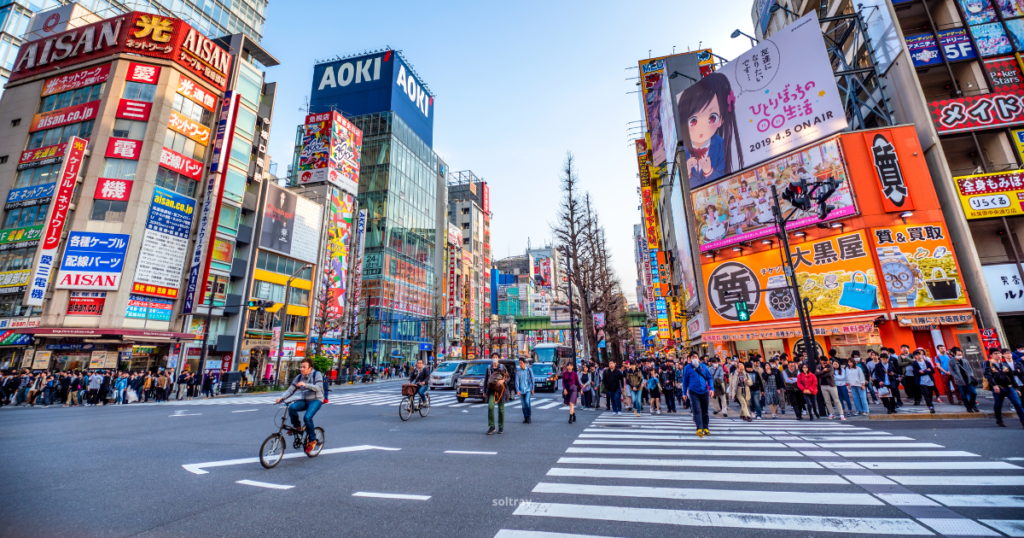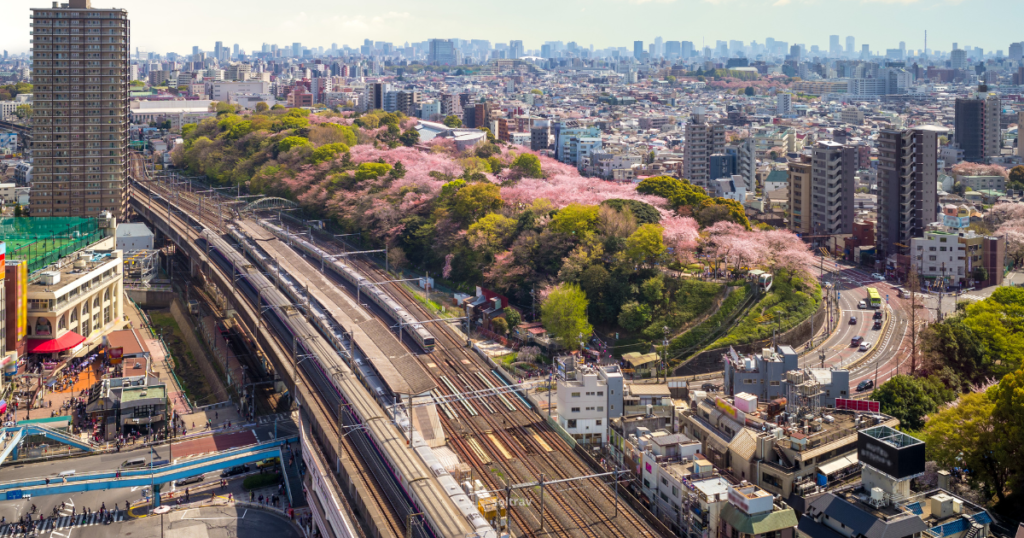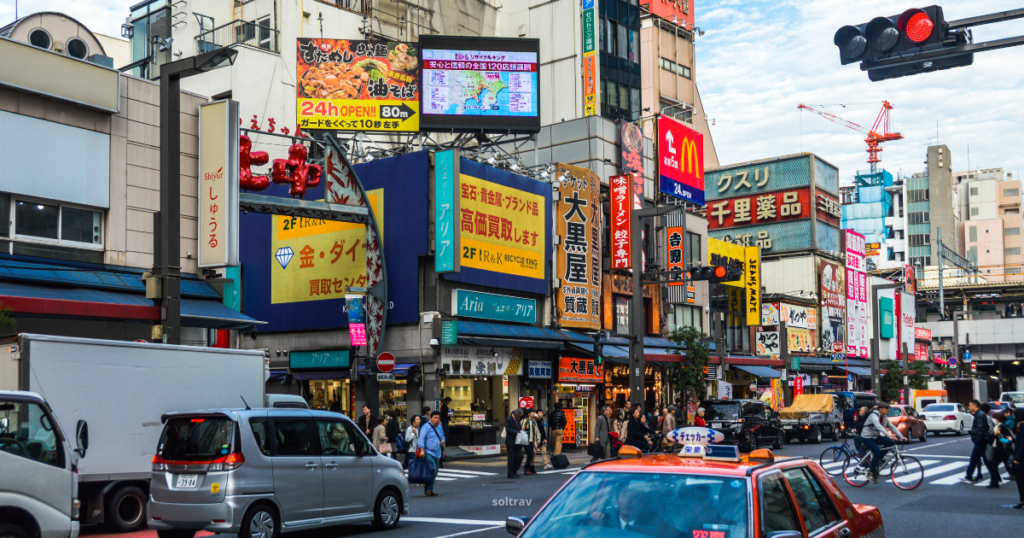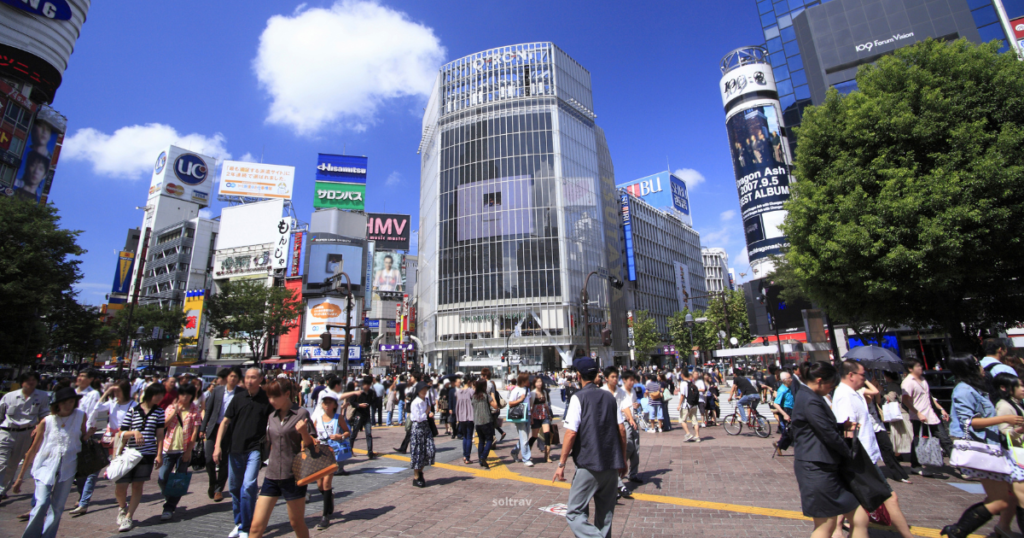Physical Address
304 North Cardinal St.
Dorchester Center, MA 02124
Physical Address
304 North Cardinal St.
Dorchester Center, MA 02124

Stand at the world’s busiest pedestrian crossing and watch 3,000 people cross simultaneously at Shibuya Crossing. This remarkable sight represents just one of many adventures that await you in Tokyo. The city buzzes with constant movement – Shinjuku Station exemplifies this energy by serving 3.6 million passengers each day.
Tokyo’s massive scale might intimidate first-time visitors, but planning your trip shouldn’t be difficult. A well-structured preparation that starts 6 months ahead will help you create a perfect 7-day experience. This complete guide shows you how to plan each day of your Tokyo adventure and balance popular attractions with lesser-known spots in Japan’s vibrant capital.

Planning your first Tokyo trip needs careful timing and preparation. Here’s a breakdown of everything you need to think over.
Spring (March to May) and fall (September to November) are the best seasons to learn about Tokyo[59]. The weather stays pleasant during these months. March to May brings cherry blossoms with comfortable temperatures around 16°C[15]. November shows off stunning autumn foliage under clear, sunny skies[60]. The summer months (July-August) can be tough with temperatures reaching 31°C and high humidity[61]. This makes sightseeing nowhere near as enjoyable.
Your daily Tokyo expenses should include these average costs:
Smart travelers can cut costs by choosing hostels (¥3,000-4,000 per night) or business hotels (¥6,000-11,000)[63].
A valid passport is mandatory throughout your Japan stay[64]. Tourist visa requirements differ based on your nationality. You should ask your local Japanese embassy about specific requirements[65]. The standard processing time takes about a week, so plan your application accordingly[65].
Winter months (January-March) give you the best flight deals to Tokyo, except during New Year celebrations[61]. Round-trip economy flights from major US cities range from USD 704 (Los Angeles) to USD 1,096 (New York)[66]. If you want to get the cheapest airfare to Tokyo, you can use WayAway to compare prices from hundreds of airlines to help you find the cheapest airfare to Tokyo. It’s worth mentioning that cherry blossom season (late March-April) and autumn foliage season (November) just need early booking as prices surge with higher demand[59]. Click here to find the cheapest prices for all airlines to Tokyo.

Tokyo’s extensive metro network serves nearly 6 million passengers daily[67]. This network is the quickest way to get around the city.
Two main operators run the metro network: Tokyo Metro with nine lines and Toei Subway with four lines[67]. These lines connect through more than 280 stations across central Tokyo[68]. The trains start at 5:00 am and run until 1:00 am. You’ll find them arriving every 3 minutes at peak times and every 10 minutes early morning and late night[69].
Each station has a simple alphanumeric system – a letter shows the line (with matching color) and a number tells you the location[70]. Signs appear in both Japanese and English, which helps first-time visitors find their way easily[68].
IC cards work like a master key to the metro. You can pick between Suica and PASMO – both need a ¥500 refundable deposit[71]. These cards work everywhere on Tokyo’s transport network and let you pay at convenience stores and vending machines too[71].
A week in Tokyo? Here are some passes that give you great value:
Your smartphone can also become your ticket – just download the Suica or PASMO app[71]. The trains run like clockwork, arriving every 3-10 minutes throughout service hours[69].

Your choice of accommodation can make or break your week in Tokyo.
Shinjuku is a fantastic place to stay with direct access to four different Shinkansen lines[73]. You’ll love its central location and amazing food scene instead of getting lost in the crowd. Shibuya makes another great home base. We picked it because it sits close to Yoyogi Park and has excellent train connections[74].
The Tokyo Station area works really well if you plan to take day trips. You can easily catch trains south to Kyoto and Osaka[73]. Ueno district won’t break your bank and connects you straight to Narita Airport via the Keisei Skyliner[73].
Tokyo hotels come in all shapes and sizes. Luxury spots can cost over ¥50,000 a night while business hotels run between ¥7,000 to ¥15,000 per night[75]. Business hotels like APA typically charge around €70 (about ¥11,000) each night[76].
A serviced apartment might be your best bet for a week-long stay. Monthly rates run from ¥150,000 to ¥500,000, which includes utilities and services[75]. These places give you:
Hostels are affordable too, with prices around ¥3,000-4,000 per night[77]. Japanese hostels are super clean and often come with private spaces behind wooden walls – much better than typical dorm setups[76].
A serviced apartment makes more sense for a week-long stay if you don’t need daily cleaning. You’ll get the best of both worlds – hotel perks with home comfort[75].

Start your Tokyo adventure right in the bustling heart of youth culture. Your first stop should be Shibuya Crossing, where you’ll see up to 3,000 people cross simultaneously in a perfectly coordinated urban dance[78]. The Shibuya Center-gai sits nearby – a lively shopping district that glows with neon lights and houses trendy boutiques. The Shibuya Niwa rooftop terrace on Tokyu Plaza’s 17th floor offers stunning views of the city[78].
Harajuku’s unique fashion scene awaits you next. Takeshita Street welcomes visitors to Tokyo’s vibrant pop culture with its colorful boutiques and sweet treats[2]. You can shop and taste local favorites like crepes, pancakes, and cotton candy. Ura Harajuku’s hidden backstreets reveal local artists’ work in spaces that double as exhibition venues[2].
Shinjuku’s electric atmosphere comes alive as night falls. The district buzzes with entertainment zones next to the world’s busiest railway station that serves 3.6 million passengers daily[16]. Omoide Yokocho, known as Memory Lane, beckons with authentic sake bars and local cuisine[16]. Golden Gai surprises visitors with its network of narrow alleys housing over 200 unique bars[17]. The Tokyo Metropolitan Government Building’s observation rooms sit 662 feet high and offer free panoramic views of the city lights[16].
Nonbei Yokochō, Shibuya’s vintage drinking strip, has kept its Shōwa-era charm alive for over 70 years[78]. You can wrap up your evening at LOST, a bar founded by prominent Japan-based YouTubers where travelers often gather to share stories[78].

Senso-ji Temple lets you experience Tokyo’s spiritual heritage. Built in 645 AD, it’s the city’s oldest Buddhist temple[18]. The massive red lantern at Kaminarimon Gate welcomes visitors to the complex. Nakamise Street adds to the authentic feel with its traditional craft shops and local food stalls.
The temple grounds go beyond spiritual significance. The Asakusa Shrine pays tribute to Senso-ji Temple’s three founders[19]. You can get amazing panoramic views of the temple complex from the eighth-floor observatory at Asakusa Tourist Culture Information Center, and it’s free[19]. The best time to visit is early morning when you can enjoy the temple’s peaceful atmosphere before crowds show up[4].
Ueno Park shows Tokyo’s rich cultural heritage. The park was once part of Kaneiji Temple, one of the city’s wealthiest temples in the Edo Period. It became one of Japan’s first Western-style public spaces in 1873[3]. The park features several amazing spots:
The park’s beauty changes with each season. While it’s famous for its 1,000+ cherry trees that bloom in late March and early April[3], it stays beautiful year-round. Bentendo Hall, an octagonal temple by Shinobazu Pond, looks stunning in every season[3]. The park’s museums, including the National Museum for Western Art and the National Science Museum, make great cultural visits in any weather[3].

Head over to Tokyo’s technological heart and spend two days in the city’s most futuristic districts.
Akihabara, we know it as Electric Town, stands as Tokyo’s tech paradise. This district started as a postwar black-market hub for electronics[5] and has grown into a showcase of Japanese breakthroughs. Yodobashi Camera and Laox dominate with their multi-floor electronics emporiums[5]. Smaller specialty shops line the side streets and sell everything from computer components to vintage gaming gear.
The district shows Japan’s gaming and anime culture at its best. Tokyo Leisure Land draws professional players of the BEMANI PRO LEAGUE[5] and has become a premier gaming destination. GiGO arcades pack their multiple floors with entertainment[5]. You’ll find casual gamers and serious enthusiasts here throughout the day.
Take a trip across Rainbow Bridge to Odaiba, a man-made island that shows modern Tokyo’s entertainment culture. The new teamLab Borderless in Azabudai Hills displays more than 50 digital artworks[21]. Art moves freely between rooms to create immersive experiences.
Immersive Fort Tokyo opened in March 2024 as the world’s first fully indoor immersive theme park[21]. This 30,000-square-meter space features 12 attractions including Sherlock Holmes-themed mysteries and anime-based escape rooms[22]. Special events change the space regularly, like the Alice in Borderland attraction added recently[21].
SHIBUYA SKY offers spectacular 360-degree views from its open-air observation deck[22]. The Paradise Lounge sits on the 46th floor, perfect to enjoy evening refreshments while taking in Tokyo’s skyline[22]. Decks Tokyo Beach houses over 90 specialty stores[23] and features popular spots like Madame Tussauds and LEGOLAND Discovery Center.

Make your last day in Tokyo special by choosing between rewarding day trips or checking out the city’s various shopping areas.
Kamakura, just [47 minutes from Shinagawa Station][24], combines culture with coastal charm. The town’s famous Daibutsu (Big Buddha) and dark volcanic sand beaches give you a different feel from central Tokyo. Hakone is another great option with its mountain views and hot springs that you can reach by taking a [90-minute journey on the Odakyu Romance Car from Shinjuku Station][25].
Yokohama stands out as an urban adventure with its beautiful port setting. The city’s Red Brick Warehouse and Japan’s largest Chinatown are perfect spots to shop and dine[26]. Nature lovers might prefer Chichibu, [just an hour and a half from Tokyo by train][26], where you can enjoy scenic boat rides and amazing mountain views.
Tokyo’s shopping scene has something for everyone. Ginza is the city’s top upmarket area with flagship stores from leading Japanese and international fashion brands[27]. Shinjuku amazes visitors with [half a dozen major department stores and countless boutiques along its streets and underground shopping arcades][27].
Each shopping area has its own unique character:
You’ll find authentic souvenirs in the [Asakusa district, especially along Nakamise Dori, which offers many traditional items][27]. Smart shoppers can get great deals at [100 yen shops throughout the city that sell everything from chopsticks to home decorations][27].

Getting around Tokyo becomes easier when you know your airport transfer options. Narita Airport, located [60 kilometers east of central Tokyo][28], connects to the city through multiple routes. The Narita Express (N’EX) takes [53 minutes][7] to reach Tokyo Station and stands out as the fastest rail option. The Keisei Skyliner takes [41 minutes][8] to reach Ueno Station and gives you a budget-friendly choice at [¥2,570][8].
Haneda Airport sits [20 kilometers south of Tokyo][28], and the Tokyo Monorail gives you quick access to Hamamatsucho Station. Express services cost [¥490 and take 13 minutes][29]. The Airport Limousine Bus runs from both airports to major hotels and stations throughout Tokyo. Fares start at [¥3,100 from Narita][8].
The Tokyo Subway Ticket gives you great value with unlimited rides on both Tokyo Metro and Toei lines. You can choose from [24-hour (¥800), 48-hour (¥1,200), and 72-hour (¥1,500) passes][30]. The Tokyo Free Ticket costs [¥1,600][30] and lets you ride JR lines, subways, and busses within Tokyo without limits for a day.
Google Maps shines when navigating Tokyo and shows accurate train times and platform details[31]. The Japan Transit Planner app helps you find routes and calculate fares across railways[32]. The Tokyo Metro Subway Map app works offline and covers all metro lines, Toei lines, and the JR Yamanote line[32]. These apps combine smoothly with Tokyo’s [IC card system, which you can now add to your smartphone][10] to pay across the network.

Tokyo’s food scene goes way beyond sushi and offers authentic experiences that won’t break your bank.
Local food lovers head to Karaage Hitosuji in Akasaka-Mitsuke for their famous fried chicken sets at [¥1,100]. Ginza Shabutsu attracts neighborhood regulars with its shabu-shabu lunch sets at [¥1,050]. The modest Beetle near Harajuku dishes out complete teishoku meals under [¥1,000] that come with rice, miso soup, and pickles[33].
Shibuya Stream features restaurants with home-style cooking at budget prices. Ginza’s upscale neighborhood hides basement-level tendon spots serving delicious tempura bowls for [¥1,000]. Yamataro stands out with its giant onigiri collection that features creative fillings like unagi cream cheese and spicy ahi poke[33].
These local favorites should be on your street food list:
Tsukiji Outer Market remains the best spot for fresh seafood street food and serves everything from grilled scallop skewers to sweet Japanese omelets[35]. The lively Jizo-dori Shopping Street pulls you in with yakitori smoke, while Togoshi Ginza Shotengai, Tokyo’s longest shopping street, showcases both old-school snacks and creative street food innovations[36].

Tokyo’s popular districts hide enchanting spots that only locals know about, just beyond the neon lights and bustling crossings.
Shibuya Coffee, a cozy spot hidden from the main streets, serves expertly brewed coffee in a laid-back setting[9]. Hoshino Coffee’s charming decor and signature soufflé pancakes make it perfect to enjoy a relaxed brunch[9].
The intimate Shibuya Art Museum draws art lovers with its rotating exhibitions from local and international artists[9]. The Shibuya Nonaka Art Space now displays unconventional art forms and interactive installations that give visitors a fresh cultural perspective[9].
Nonbei Yokochō, a vintage drinking strip, has managed to keep its Shōwa-era charm and makes for an authentic evening out[9]. Local residents love the tiny vintage stores that resemble treasure chests and sell everything from retro clothing to unique accessories[37].
The Hanazono Shrine sits just steps away from busy streets and provides a peaceful escape where local flea markets happen regularly[38]. Visitors can experience authentic Tokyo life here, away from tourist crowds.
Omoide Yokocho, which locals fondly call Memory Lane, is home to authentic sake bars and local eateries[39]. The Vampire Café adds an unusual twist to dining in the upscale shopping district[40].
The 8bit Cafe takes you back to the 1980s gaming era[40], while Ninja Akasaka restaurant’s staff trained as ninjas create an extraordinary dining adventure[40]. These hidden gems ended up showing Tokyo’s lesser-known charms in the most authentic way.

Your week in Tokyo becomes richer as you experience authentic Japanese culture through local immersion and respectful participation in traditions.
Harmonica Alley in Kichijoji buzzes with activity during its vibrant morning market from 8:00 to 11:00 on the second Sunday each month[6]. YEBISU Marche brings organic and natural products to life every second and fourth Sunday from 11:00 to 17:00[6]. The United Nations University Farmer’s Market stands out as one of Tokyo’s most enduring markets where local farmers from the greater Tokyo area showcase their produce[41].
Seafood lovers should head to Toyosu Wholesale Fish Market early. The famous tuna auction unfolds between 5:30 a.m. and 6:30 a.m., visible from the observation deck[41]. The Tsukiji Outer Market retains its nostalgic charm with stalls that sell dried condiments and fresh seafood[41].
Japanese temples deserve utmost respect through specific customs. Here’s what you should know:
Each temple has its own photography rules – look for signs or ask the staff about permitted areas[42]. The tradition suggests you should postpone your visit if you feel unwell or have an open wound[43]. Many temples let you experience early morning Zen meditation sessions, though you might need to book ahead[6].
Japanese culture welcomes visitors who show genuine interest in its traditions. English-speaking experts help first-time participants[12]. These traditional experiences range from visual arts to physical activities. You don’t need previous training or language skills to participate[12].

Tokyo becomes a stunning playground of neon lights and vibrant energy when night falls.
The Meguro River welcomes visitors with a peaceful evening stroll through the Nakameguro district. A path from the station’s East Exit 1 leads to riverside spots lined with lit-up shops and cafes[44]. The Rainbow Bridge walk to Odaiba rewards you with breathtaking views of Tokyo Bay’s illuminated skyline[45].
The path from Hie Shrine through Akasaka lets you experience a cultural evening with peaceful lantern-lit shrine grounds[45]. The walk from Shibuya to Daikanyama blends urban energy with sophisticated charm and features the iconic Namikibashi Bridge[45].
Each of Tokyo’s entertainment districts has its own unique character:
Ramen Nagi in Shinjuku’s Golden Gai serves their signature sardine-based broth around the clock[47]. Isomaru Suisan keeps its doors open all night with fresh seafood and grilled fish near major stations[48].
Locals love gathering under Yurakucho’s train tracks at popular after-work spots[14]. Omoide Yokocho in Shinjuku comes alive until dawn with authentic izakayas and local dishes[14]. Matsuya and other chain restaurants serve reliable comfort food options 24/7[48].
Most central Tokyo spots stay open late, though last trains leave around midnight[49]. Jonathan’s and other family restaurants provide comfortable spaces to wait for the first morning train if you miss the last one[48].

Your Tokyo adventure starts with understanding cultural nuances and practical tips that will improve your experience.
Simple Japanese phrases will open doors to authentic interactions. We learned that “Sumimasen” works for multiple purposes – it means excuse me, sorry, and thank you based on the situation[50]. “Arigatou gozaimasu” expresses gratitude formally, and “Kudasai” helps you request items or services[51]. Tech-savvy travelers can use “Wi-fi arimasuka?” to find internet access points[51].
Japanese social customs need careful attention. You should avoid body contact during everyday interactions[1]. Taking off shoes is a must when entering homes, and you’ll find a dedicated entrance area called “genkan” for shoe removal[52]. The host’s seating arrangements matter – the seat furthest from the entrance is the most prestigious[52].
Quiet conversations work best on trains, and phone calls are not welcome[53]. People walk on the left side of paths, while escalator rules ask you to stand on the left so others can pass on the right[52].
Smart budgeting makes Tokyo available to everyone without sacrificing experiences. These tested strategies help you get the most from your budget:
Japanese convenience stores sell quality meals starting at ¥500[11]. Traditional festivals offer free cultural experiences year-round with affordable food vendors[13]. Department stores’ fresh food sections have great discounts just before closing time[11].

Smart planning helps you make the most of your time in Tokyo and turns waiting hours into amazing experiences.
Disney Premier Access lets you skip lines at popular attractions, with prices starting at ¥1,500-2,000 per person[54]. You can book another attraction 60 minutes after your first purchase[55]. The 40th Anniversary Priority Pass gives you free express queue access, and you can book it every 120 minutes[54].
You can save 5-10 minutes at customs by filling out immigration forms online before arrival to get a QR code[56]. Haneda Airport cuts down your transfer time by a lot compared to Narita because it’s closer to central Tokyo[56].
The early bird catches the worm in Tokyo. Tuesday and Thursday mornings are quiet times to explore department stores[15]. Major temples like Sensoji become peaceful spots after dark when shops in Nakamise close down[15].
The best seasonal timing:
You’ll save time by grouping attractions in the same area. An eSIM might work better than pocket WiFi to stay connected while keeping your usual numbers[56]. The Tokyo Pass from Klook has multiple attractions and optional 72-hour subway tickets[57].
Smart ways to move between sites:
Smart planning leads to amazing experiences in Tokyo. A week in Japan’s capital gives you the perfect mix – ancient temples next to modern districts, and quiet local spots away from tourist hotspots. Good preparation helps you traverse the city with ease, from the buzz of Shibuya to peaceful moments in Ueno Park’s gardens.
Getting familiar with Tokyo’s transport, learning basic etiquette, and finding budget options makes your trip smoother and cheaper. The city’s morning markets, street food stalls, and quiet neighborhoods add something special to the main attractions. You can make each day count by visiting temples early and grouping nearby spots together.
Want to snag the best deal on flights to Tokyo? WayAway has a price alert feature that notifies you when prices drop. Don’t miss out on the cheapest tickets! WayAway compares airfares from hundreds of airlines and travel agencies. Get notified and get going!
🔔 Set Up a WayAway Price Alert for Tokyo Flights Now! This piece, good timing, and careful planning that starts six months ahead will help create lasting memories of both famous sights and authentic local spots.
Q1. How many days should I plan for my first visit to Tokyo? For a first-time visitor, 3-4 days in Tokyo is recommended. This allows you to experience the city’s highlights while leaving time to explore other parts of Japan. If you have a week in Japan, consider spending 3 days in Tokyo and 4 in Kyoto for a well-rounded trip.
Q2. What’s a reasonable budget for a week in Tokyo? A mid-range budget for one person for a week in Tokyo is around $2000. This covers basic flights, accommodation in Airbnbs or mid-range hotels, casual dining, and public transportation. Luxury travelers might spend between $3500 to $10000 for a week, depending on their preferences.
Q3. Which area is best for first-time visitors to stay in Tokyo? Shinjuku is an excellent choice for first-time visitors. It’s centrally located with easy access to other parts of the city, offers a variety of accommodation options, and features bustling streets with numerous dining and shopping choices. It also provides convenient connections to major train lines for exploring Tokyo and beyond.
Q4. How can I plan a 7-day itinerary for Tokyo? A sample 7-day Tokyo itinerary could include: Day 1 – Shibuya, Harajuku & Shinjuku; Day 2 – Northern Tokyo (Asakusa, Ueno); Day 3 – Shinjuku, Minami-Aoyama & Nishiazabu; Day 4 – Day trip to Mt. Fuji or Hakone; Day 5 – Imperial Palace & Tokyo Tower; Day 6 – Tsukiji Outer Market & Ginza; Day 7 – Last-minute shopping and departure.
Q5. What are some money-saving tips for Tokyo? To save money in Tokyo, consider eating at 100-yen shops for budget-friendly meals and snacks, visit restaurants during lunch hours for cheaper set meals, shop at convenience stores after 8 PM for discounted fresh meals, and use IC cards for seamless and often discounted payments across transportation and stores. Also, look out for free cultural experiences at traditional festivals throughout the year.
[1] – https://www.japan.travel/en/guide/understanding-and-mastering-japanese-manners-and-etiquette/
[2] – https://www.magical-trip.com/product/71206ca6-2c1c-4efa-ad0e-201f71b90e28
[3] – https://www.japan-guide.com/e/e3019.html
[4] – https://trulytokyo.com/tokyo-2-day-itinerary/
[5] – https://www.gotokyo.org/en/destinations/central-tokyo/akihabara/index.html
[6] – https://www.gotokyo.org/en/see-and-do/morning/index.html
[7] – https://www.klook.com/en-US/blog/narita-airport-to-tokyo-guide/
[8] – https://www.timeout.com/tokyo/travel/how-to-get-to-and-from-tokyo-narita-airport
[9] – https://www.agoda.com/travel-guides/japan/tokyo/discover-shibuyas-hidden-gems-unique-attractions-await/
[10] – https://www.gotokyo.org/en/plan/getting-around/public-transport/index.html
[11] – https://www.nomadicmatt.com/travel-blogs/japan-budget-tips/
[12] – https://www.japan.travel/en/japan-magazine/2311_take-a-deep-dive-into-limited-time-cultural-immersion/
[13] – https://www.lonelyplanet.com/articles/japan-on-a-budget
[14] – https://www.gotokyo.org/en/see-and-do/nightlife/index.html
[15] – https://santorinidave.com/best-time-to-visit-tokyo
[16] – https://www.tokyolocalized.com/post/things-to-do-in-shinjuku-at-night
[17] – https://photo-trips.com/what-to-do-in-shinjuku-at-night/
[18] – https://www.thetravelpockets.com/new-blog/2-day-itinerary-tokyo-japan
[19] – https://matcha-jp.com/en/5112
[20] – https://matcha-jp.com/en/1084
[21] – https://livejapan.com/en/in-tokyo/in-pref-tokyo/in-tokyo_train_station/article-a0005447/
[22] – https://www.klook.com/en-US/blog/new-things-to-do-in-japan/
[23] – https://travel.rakuten.com/contents/usa/en-us/guide/things-to-do-odaiba/
[24] – https://www.forbes.com/sites/forbestravelguide/2024/09/17/3-unforgettable-day-trips-from-tokyo/
[25] – https://guide.michelin.com/us/en/article/travel/best-day-trips-from-tokyo
[26] – https://www.japan.travel/en/ca/inspiration/10-best-day-trips-from-tokyo/
[27] – https://www.japan-guide.com/e/e3053.html
[28] – https://www.japan-experience.com/transportation/airport-transfers/tokyo
[29] – https://trulytokyo.com/tokyo-airport-transport/
[30] – https://www.japan.travel/en/au/plan/useful-tickets-tokyo/
[31] – https://thenavigatio.com/travel-apps-for-japan/
[32] – https://www.japan.travel/en/plan/useful-apps/
[33] – https://www.timeout.com/tokyo/restaurants/best-cheap-eats-in-tokyo
[34] – https://www.cityunscripted.com/travel-magazine/street-food-tokyo
[35] – https://www.cntraveler.com/gallery/best-places-to-eat-like-a-local-in-tokyo
[36] – https://www.cityunscripted.com/travel-magazine/tokyo-street-food
[37] – https://www.agoda.com/travel-guides/japan/discover-hidden-gems-fun-places-to-go-in-shibuya/
[38] – https://lexion13.xsrv.jp/unveiling-shinjuku-15-must-see-attractions-and-hidden-gems/
[39] – https://livejapan.com/en/in-tokyo/in-pref-tokyo/in-shinjuku/article-a0001986/
[40] – https://www.atlasobscura.com/things-to-do/tokyo-japan
[41] – https://www.byfood.com/blog/tokyo/best-food-markets-in-tokyo
[42] – https://www.japan-guide.com/e/e2057.html
[43] – https://en.japantravel.com/guide/shrine-temple-etiquette/20924
[44] – https://www.timeout.com/tokyo/things-to-do/most-scenic-night-walks-in-tokyo
[45] – https://tokyocheapo.com/lifestyle/tokyo-night-walking-tour/
[46] – https://boutiquejapan.com/tokyo-nightlife-guide/
[47] – https://www.timeout.com/tokyo/restaurants/best-24-hour-restaurants-in-tokyo
[48] – https://www.byfood.com/blog/tokyo/best-24-hour-restaurants-tokyo
[49] – https://alljapantours.com/japan/food-and-drinks/bars-and-brewery/tokyo-nightlife/
[50] – https://boutiquejapan.com/essential-japanese-words-phrases-for-travelers-to-japan/
[51] – https://www.jrailpass.com/blog/basic-japanese-phrases-for-traveling
[52] – https://culturalatlas.sbs.com.au/japanese-culture/japanese-culture-etiquette
[53] – https://www.cntraveler.com/story/15-insider-tips-for-your-next-trip-to-tokyo
[54] – https://tripswithtykes.com/tokyo-disney-line-strategies/
[55] – https://www.tokyodisneyresort.jp/en/tdl/guide/disneypremieraccess.html
[56] – https://nickgray.net/tokyo23/
[57] – https://girleatworld.net/tokyo-itinerary-first-time-visitor/
[58] – https://ronitreviews.com/some-quick-tokyo-tips-for-you
[59] – https://www.lonelyplanet.com/articles/best-time-to-visit-tokyo
[60] – https://trulytokyo.com/best-time-to-go-to-tokyo/
[61] – https://www.roughguides.com/articles/best-time-to-visit-tokyo/
[62] – https://www.budgetyourtrip.com/japan/tokyo
[63] – https://www.jal.co.jp/ar/en/guide-to-japan/plan-your-trip/tips/budgeting-for-japan.html
[64] – https://travel.state.gov/content/travel/en/international-travel/International-Travel-Country-Information-Pages/Japan.html
[65] – https://www.mofa.go.jp/j_info/visit/visa/
[66] – https://www.jal.co.jp/flights/en-us/flights-to-tokyo
[67] – https://www.contexttravel.com/blog/articles/tokyos-subway-and-trains-how-to-confidently-navigate-the-tokyo-metro-system
[68] – https://www.gotokyo.org/en/plan/getting-around/subways/index.html
[69] – https://www.voyagedmagazine.com/tokyo-subway-your-essential-guide-to-tokyos-public-transport/
[70] – https://www.forbes.com/sites/geoffreymorrison/2016/05/21/6-tips-for-navigating-tokyos-subway-system/
[71] – https://www.gotokyo.org/en/plan/getting-around/ic-card/index.html
[72] – https://www.japan-guide.com/e/e2017.html
[73] – https://tokyocheapo.com/accommodationcat/where-to-stay-in-tokyo/
[74] – https://www.bontraveler.com/where-to-stay-in-tokyo-japan/
[75] – https://e-housing.jp/post/serviced-apartments-in-tokyo
[76] – https://pleasebeseatedfortakeoff.com/where-to-stay-in-tokyo-on-a-budget/
[77] – https://thewayfaringsoul.com/best-area-stay-tokyo-first-time-japan/
[78] – https://tokyocheapo.com/entertainment/things-to-do-in-shibuya/